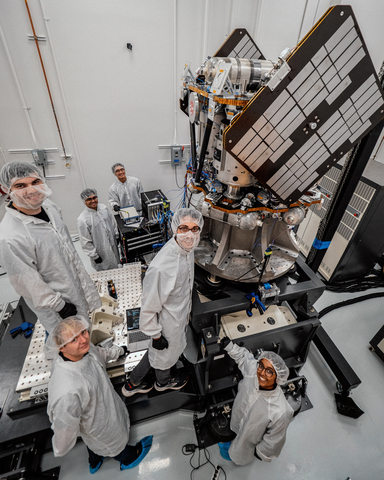Rocket Lab Integrating Twin Spacecraft for Mission to Mars for NASA
- Rocket Lab is building two spacecraft for NASA's ESCAPADE mission, which will investigate Mars' unique hybrid magnetosphere.
- The spacecraft will carry instruments to measure magnetic field, ions and electrons, plasma density, and solar extreme ultraviolet flux.
- Rocket Lab's spacecraft are undergoing environmental testing, including vibration, thermal vacuum, and electromagnetic compatibility testing.
- Rocket Lab has successfully concluded RF compatibility testing with NASA's Deep Space Network.
- The spacecraft are planned for launch in 2024 to low Earth orbit aboard a Blue Origin New Glenn launch vehicle.
- None.
Insights
Analyzing...

One of two Rocket Lab-built spacecraft for NASA and UCBSSL's ESCAPADE mission to Mars. Rocket Lab photo by Austin Adams.
The ESCAPADE mission, led by Dr. Rob Lillis at the University of
To ensure that the two spacecraft are ready for the harsh environment of space and their roughly 230-million-mile journey to the red planet, the Rocket Lab Space Systems team has successfully passed System Integration Review (SIR) and is proceeding with integration of the flight hardware in preparation for launch. Integration includes both the spacecraft bus with Rocket Lab-manufactured solar arrays, reaction wheels, star trackers, separation systems, radios, and flight software and the flight instruments being delivered from UCB and other mission partners. In addition to a battery of functional tests to verify performance, the spacecraft are undergoing a full environmental test campaign, including vibration, thermal vacuum, and electromagnetic compatibility testing. The Company has also concluded RF compatibility testing with NASA’s Deep Space Network (DSN), which will communicate with Rocket Lab’s Frontier-X radios on both spacecraft and provide navigation services to the mission.
“Reaching the flight integration phase for a new spacecraft is a significant milestone, especially for a complex interplanetary mission like this,” said Rocket Lab founder and CEO Peter Beck. “Building on the successful delivery of a spacecraft to lunar orbit for NASA last year, it's a privilege to be developing a spacecraft headed for deep space to perform Decadal-class science with our partners at UC Berkeley.”
The ESCAPADE spacecraft integration and test is taking place at Rocket Lab’s advanced spacecraft development and manufacturing complex within the Company’s
ESCAPADE is being developed under NASA’s Small Innovative Missions for Planetary Exploration (SIMPLEx) program in the Science Mission Directorate (SMD) and is the first Heliophysics mission to another planet. The mission is led by the University of
+ About Rocket Lab
Founded in 2006, Rocket Lab is an end-to-end space company with an established track record of mission success. We deliver reliable launch services, satellite manufacture, spacecraft components, and on-orbit management solutions that make it faster, easier, and more affordable to access space. Headquartered in
+ Forward Looking Statements
This press release contains forward-looking statements within the meaning of the Private Securities Litigation Reform Act of 1995. We intend such forward-looking statements to be covered by the safe harbor provisions for forward looking statements contained in Section 27A of the Securities Act of 1933, as amended (the “Securities Act”) and Section 21E of the Securities Exchange Act of 1934, as amended (the “Exchange Act”). All statements contained in this press release other than statements of historical fact, including, without limitation, statements regarding our launch and space systems operation, launch schedule and window, safe and repeatable access to space, Neutron development, operational expansion and business strategy are forward-looking statements. All statements contained in this press release other than statements of historical fact, including, without limitation, statements regarding our launch and space systems operation, launch schedule and window, safe and repeatable access to space, Neutron development, operational expansion, business strategy, and expectations relating to our financial condition, results of operations, plans, objectives and future performance are forward-looking statements. The words “believe,” “may,” “will,” “estimate,” “potential,” “continue,” “anticipate,” “intend,” “expect,” “strategy,” “future,” “could,” “would,” “project,” “plan,” “target,” and similar expressions are intended to identify forward-looking statements, though not all forward-looking statements use these words or expressions. These statements are neither promises nor guarantees, but involve known and unknown risks, uncertainties and other important factors that may cause our actual results, performance or achievements to be materially different from any future results, performance or achievements expressed or implied by the forward-looking statements, including but not limited to the factors, risks and uncertainties included in our Annual Report on Form 10-K for the fiscal year ended December 31, 2022, as such factors may be updated from time to time in our other filings with the Securities and Exchange Commission (the “SEC”), accessible on the SEC’s website at www.sec.gov and the Investor Relations section of our website at www.rocketlabusa.com, which could cause our actual results to differ materially from those indicated by the forward-looking statements made in this press release. Any such forward-looking statements represent management’s estimates as of the date of this press release. While we may elect to update such forward-looking statements at some point in the future, we disclaim any obligation to do so, even if subsequent events cause our views to change.
View source version on businesswire.com: https://www.businesswire.com/news/home/20231018369299/en/
+ Rocket Lab Media Contact
Michael Atchue
media@rocketlabusa.com
Source: Rocket Lab USA, Inc.







